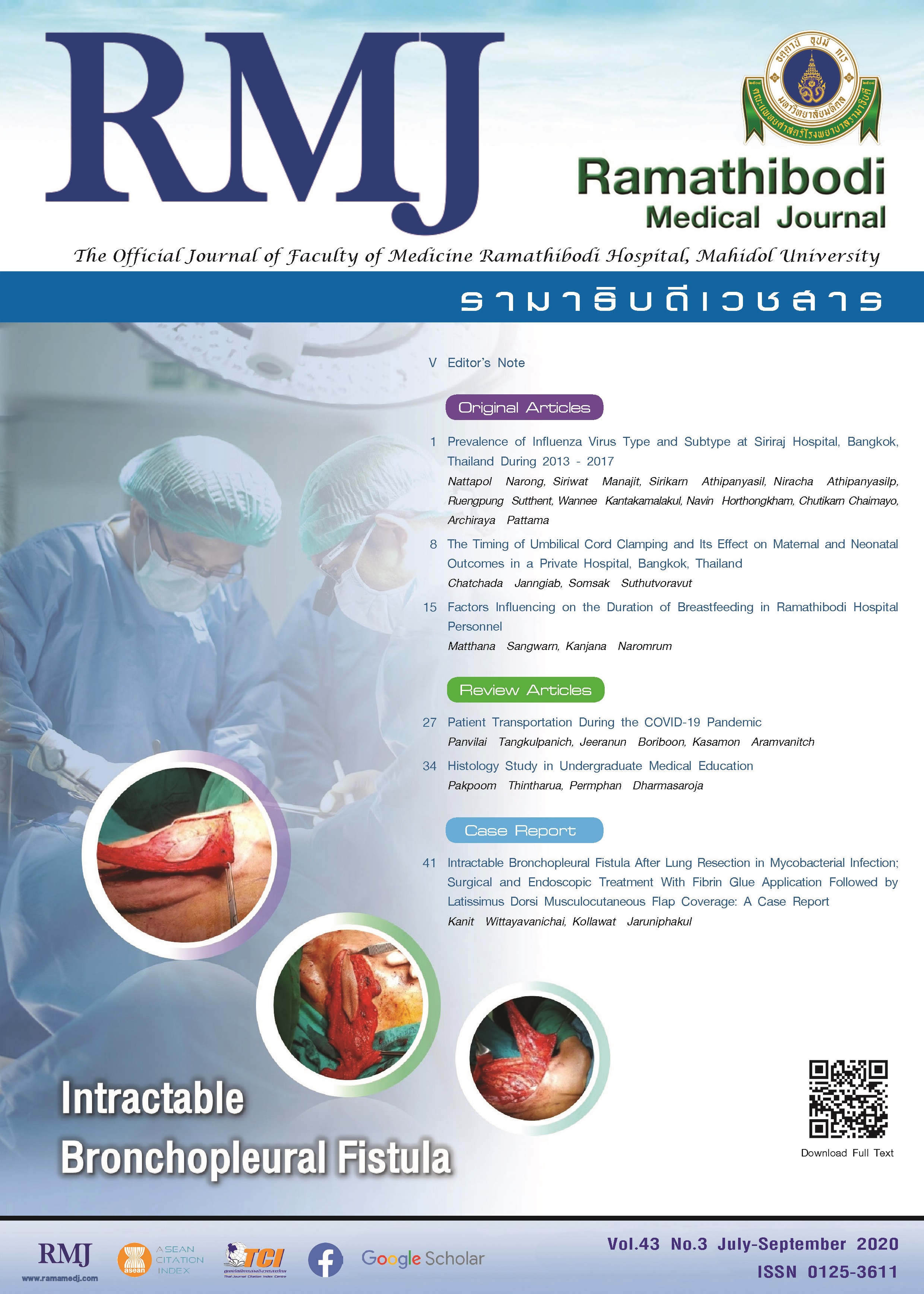Factors Influencing on the Duration of Breastfeeding in Ramathibodi Hospital Personnel
DOI:
https://doi.org/10.33165/rmj.2020.43.3.218806Keywords:
Breastfeeding, Hospital personnelAbstract
Background: Breast milk is the best food for newborn and the important base in physical mental intellectual and emotional development.
Objective: To identify rate of exclusive breastfeeding at least 6 months and to influencing factors on duration of breastfeeding in Ramathibodi Hospital personnel.
Methods: This study was a cross-sectional study. Participants were 483 Ramathibodi Hospital personnels who gave birth at Ramathibodi Hospital from October 1, 2012, to September 30, 2015. Instruments were demographic data and breastfeeding history questionnaires. Data were analyzed by descriptive statistics and the correlation between the factors associated with breastfeeding used chi-square test and multiple logistic regression analysis.
Results: Questionnaires were returned 329 (68%). Exclusive breastfeeding for first 6 months was 20%. The finding showed that age, level of education, occupation, average family income per month, duration of breastfeeding intention, breastfeeding instruction at antenatal care clinic, and personnel have breast milk before discharge were related to the duration of breastfeeding for more than or equal 6 months (P < .05). Occupation and duration of breastfeeding intention predicted the duration of breastfeeding in Ramathibodi Hospital personnel 17.2%.
Conclusions: This study showed that high age, high level of education, maternal occupation, high family income, duration of breastfeeding intention, breastfeeding instruction at antenatal care clinic, and personnel having breast milk before discharge related to the duration of breastfeeding for equal or more than 6 months. The predictable factors on the duration of breastfeeding for equal or more than 6 months were occupation and duration of breastfeeding intention.
References
Victora CG, Bahl R, Barros AJ, et al. Breastfeeding in the 21st century: epidemiology, mechanisms, and lifelong effect. Lancet. 2016;387(10017):475-490. doi:10.1016/S0140-6736(15)01024-7.
Horta BL, Loret de Mola C, Victora CG. Breastfeeding and intelligence: systematic review and meta-analysis. Acta Paediatr. 2015;104(467):14-19. doi:10.1111/apa.13139.
Patel AL, Kim JH. Human milk and necrotizing enterocolitis. Semin Pediatr Surg. 2018;27(1):34-38. doi:10.1053/j.sempedsurg.2017.11.007.
Chowdhury R, Sinha B, Sankar MJ, et al. Breast feeding and maternal health outcomes: a systematic review and meta-analysis. Acta Paediatr. 2015;104(467):96-113. doi:10.1111/apa.13102.
World Health Organization, UNICEF. Global Strategy for Infant and Young Child Feeding. Geneva, Switzerland: World Health Organization; 2003. https://apps.who.int/iris/bitstream/handle/10665/42590/9241562218.pdf;jsessionid=75CF5A98096449E69AE01EC3F0E52362?Sequence=1. Accessed January 6, 2020.
World Health Organization. Nutrition: Global Targets 2025. http://www.who.int/nutrition/global-target-2025/en/. Accessed January 6, 2020.
National Statistical Office and United Nations Children’s Fund. Thailand Multiple Indicator Cluster Survey 2015 - 2016, Final Report. Bangkok: NSO and UNICEF; 2016. https://www.unicef.org/thailand/sites/unicef.org.thailand/files/2018-06/Thailand_MICS_Full_Report_EN_0.pdf. Accessed January 6, 2020.
Dennis CL, Gagnon A, Van Hulst A, Dougherty G, Wahoush O. Prediction of duration of breastfeeding among migrant and Canadian-born women: results from a multi-center study. J Pediatr. 2013;162(1):72-79. doi:10.1016/j.jpeds.2010.06.041.
Payakkaraung S, Sangperm P, Samart C. Breastfeeding problem in early postpartum period: mother’s experiences. J Nurs Sci. 2016;34(3):30-40.
Chanapai S, Sinsuksai N, Thananowan N, Phahuwatanakorn W. Knowledge, attitude, self-efficacy, spousal and nurse support predicting 6 weeks exclusive breastfeeding. J Nurs Sci. 2014;32(1):51-60.
Wangsawat T, Kaleang N, Phibal A, Jaisomkom R, Hayeese W. Factors influencing intention to exclusive breastfeeding for 6 months of mothers in Naradhiwat province. Nursing Journal. 2014;41(suppl):123-133.
Weber D, Janson A, Nolan M, Wen LM, Rissel C. Female employees’ perceptions of organizational support for breastfeeding at work: findings from an Australian health service workplace. Int Breastfeed J. 2011;6:19. doi:10.1186/1746-4358-6-19.
Tavoulari EF, Benetou V, Vlastarakos PV, et al. Factors affecting breastfeeding duration in Greece: What is important? World J Clin Pediatr. 2016;5(3):349-357. doi:10.5409/wjcp.v5.i3.349.
Puapornpong P, Raungrongmorakot K, Hamontri S, Ketsuwan S, Wongin S. Comparison of exclusive breastfeeding rate at six months postpartum between hospital personnel and general women. J Med Health Sci. 2015;22(3):8-14.
Apartsakun P. Discouraging factors of breastfeeding among Thai women. Journal of Public Health Nursing. 2016;30(20):133-146.
Moore ER, Bergman N, Anderson GC, Medley N. Early skin-to-skin contact for mothers and their healthy newborn infants. Cochrane Database Syst Rev. 2016;11:CD003519. doi:10.1002/14651858.CD003519.pub4.
Chisuwan C, Prasopkittikun T, Sangperm P, Pakkaraung S. Predictive power of support from husbands, grandmothers, and nurses on duration of exclusive breastfeeding. J Nurs Sci. 2012;30(1):70-80.
Tsai SY. Impact of a breast feeding-friendly workplace on an employed mother’s intention to continue breast feeding after returning to work. Breastfeed Med. 2013;8(2):210-216. doi:101089/bfm.2012.0119.

















